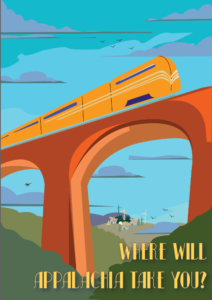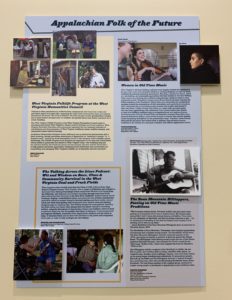By Sally Brown Deskins, Exhibits Coordinator, West Virginia University Libraries
This article appeared in the Volume 1, Issue 3 Winter 2020 issue of the Appalachian Curator. Click here to view a PDF of the full issue.
Curating Appalachian Futures, an interdisciplinary project spearheaded by myself, Exhibits Coordinator for West Virginia University Libraries, was a complex, collaborative project including contributions and partners region wide. This article will take a look at the process of creating the broad, tremendous exhibit with 50 artistic, scholarly and community contributors and the mini-conference that stemmed from it, further contextualizing and giving impact to the idea beyond the walls.

Appalachian Futures is the main exhibit developed by the WVU Art in the Libraries committee spanning the main spaces of the Downtown Campus Library. The committee, consisting of twelve librarians and cross-campus faculty, also develops and approves exhibits and displays for the Health Sciences and Evansdale Campus Libraries. Appalachian Futures follows WATER: An Interdisciplinary Exhibit Exploring Life’s Critical Resource (2018-19), including contributions from over 40 regional scholars, artists and activists, the first collaborative exhibit I curated after coming on board as Exhibits Coordinator. Before I took the position in spring of 2017, the librarian-only committee coordinated the exhibits themselves, and did not curate or design original exhibits.
The Art in the Libraries committee brainstormed a list of about a dozen broad exhibition ideas including immigration, collections, environment, and more; and eventually voted on Appalachian Futures, with a tie-in with the WVU Humanities Center, whose 2018-19 theme for programming was Future oriented as well.
To curate Appalachian Futures, I along with the WVU Humanities Center Director, formed a regional expert committee to develop the call for content summary to disperse to area universities, think tanks, artists groups, organizations and list serves, etc. The exhibition committee consisted of a music historian, an art historian, an artist/curator, two poets, an historian, a folklorist, an artist/activist, myself and the WVU Humanities Director, also a theatre scholar. With the committee, we developed a thoughtful outline for the exhibit with themes outlined and contextualized including Growth of Diverse Perspectives; Science, Education and Industries; Future of Appalachian Traditions; Speculative Futures; and Class Projects.
After outlining the exhibit call, it was dispersed by the exhibition and Art in Libraries committee, as well as the Libraries Communications Coordinator, to various outlets and groups, seeking an array of perspectives and media contributions. While the call was dispersed and we awaited submissions, I also had to seek funding to design and produce this exhibit. A call for exhibit sponsors was included in the call for submissions, but proactive work had to be done in order to successfully create this exhibit.
Teaming with the Libraries Development Director and Dean, we were able to obtain partnerships from regional libraries including the West Virginia Library Commission, Marshall University Libraries, and Appalachian State University Libraries. Each of these organizations also agreed to host the exhibit after the original debut at WVU, a bonus for the partners involved. Partnership with the printer allowed for a small discount on printing the exhibition panels and vinyl installations, as well as partnerships with WVU Reed College of Media, First United Bank & Trust, and independent donor Catherine Wilson Jones. I, with the help of the WVU Humanities Center Director, also submitted to the West Virginia Humanities Council for a grant to support the design and production, which was not accepted. With the Dean of WVU Libraries, I also submitted grant applications to the WVU internal Community Engagement grant, which we had previously received for a community driven art project, which was also not accepted. I, with one of the exhibition committee members, also applied for the WVU Humanities Center Collaborative Project grants, to support the design and production of the exhibit (the Director was not on the deciding committee), which was accepted. I also submitted a Community Engagement grant application with Arts Monongahela, our city’s arts council, which was accepted. So all in all, we received enough support to hire a professional designer, which we did, to make this exhibit shine; as well as outsource the printing of the panels.

Meanwhile, by the deadline, we had received eighty exhibition submissions, from music to artwork, and historical scholarship to environmental work; from both WVU students and faculty, to artists and professionals from as far away as Chicago, New York, and Florida, with Appalachian ties. The submissions included a form with a title, abstract, contact information, and its relation to one or more of the exhibition themes. Once I received them all, I had my intern organize a Google file with the submissions by theme on an excel sheet with corresponding folders, so both the exhibit and Art in the Libraries committees could review the submissions. I met with both committees separately, two times, to discuss all of the submissions. I took feedback from both committees and brought it to review with the WVU Humanities Center Director, and made ultimate decisions based on themes, feasibility, and space. Because the Libraries do not have facilities to host plays or large music concerts, we invited those folks to be listed as potential programming ideas for future exhibition venues. Because the Libraries do not have the capability to provide vital security or handling insurance for fine art, we selected some to be reproduced on exhibition panels and vinyl installations; and we also hosted a mini-complementary exhibit of selected original work for two months only to be on display at WVU. Ultimately 50 contributions were selected for the main exhibition and ten for the complementary fine art exhibit.
Once communications were made for acceptances and rejections, and final versions were sent and received, I began to curate the content into the themes and then into subthemes, to create the integrated display. Faculty librarians helped me edit the content in their areas of expertise, and each edited written submission was approved by original authors. Once this content was complete, I compiled it into folders on a Google drive to send to the designer, to integrate with imagery and creative design to create the panels to not only fit in the WVU Downtown Campus Library, but to be flexible to go on display in the other spaces, most of which have considerably smaller wall space. As such, the designer planned them in such a way that the venues can select which panels to include.
As the panels were being designed, an interest in formulating a mini-conference around Speculative Futures came about via the WVU Humanities Center. We partnered again on an internal WVU grant to support mini conferences, and it was accepted. So, another conference committee was formed to fully develop this theme, call, and schedule for later in the year, to both complement and further promote thinking around this broad topic, to expand its impact.
At the same time, the exhibit design and installation was complete and the promotion was set in motion; traditional media as well as social media strategies were taken on to promote this truly multidisciplinary exhibit opening, including live music, interactive gaming and brief talks by the Dean of Libraries and one of the exhibit contributors, a historian. An interactive element was also developed with help from the exhibition committee, including “Question Stations” where viewers could respond to philosophical questions around the future of Appalachia, in collaboration with WVU Philosophy Department.
Other programming developed in conjunction includes Women of Appalachia: An Invitational Exhibit, a visual exhibit of artwork by regional women artists in March 2020, in celebration of Women’s History Month. An exhibit reception with a curator’s talk will also take place. An informal exhibit, REMIXing the Archives, was curated, a juried exhibit of digital and print collages using WVU’s West Virginia & Regional History Center’s online collections.
Moving forward, an exhibition manual is being developed for the futures venues of the exhibition. The curating of the spring Speculative Futures mini-conference to be held at WVU continues, and as other exhibitions at other Libraries rotate, the next featured exhibit inspired by the 2020 suffrage centennial, Undefeated: Canvas(s)ing the Politics of Voter Suppression Since Suffrage, is currently being developed with a regional team of experts and the Art in the Libraries team.
Exhibitions in libraries provide this wonderful opportunity to build exhibitions around their limitations of security and alternative display space, in creating rich, diverse, multi-disciplinary exhibits with both campus and community members, evoking the Library’s role as both information documenters and holders as well as neutral information transmitters.